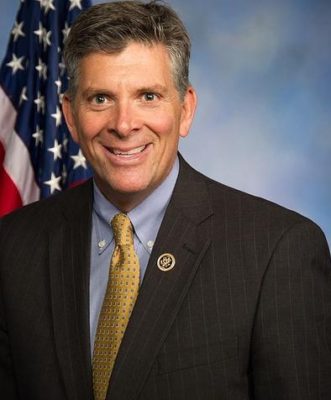Illinois’ 18th District Representative is pitching an idea for how to fix Congress.
The Congress of Tomorrow Project, presented by Republican Darin LaHood and 3rd District Democratic Representative Dan Lipinski, aims to make Congress “more efficient, effective and accountable.”
LaHood spoke with WLDS-WEAI News this morning and explained that warning signs of governmental deterioration were evident across a wide spectrum of issues and conditions at the conclusion of the 113th Congress in December of 2014.
LaHood highlighted several dates in the past where Congress has “lost its ground” and had to reset. Despite LaHood’s limited time in Congress, he “sees dysfunction everyday” and feels change is necessary.
“People complain all the time about the dysfunction of Congress. They say it doesn’t work, we don’t do the work we are suppose to do and we haven’t passed all the appropriation bills. Just this week we had to pass a continuing resolution to fund the government. Congress over the last 15 to 20 years hasn’t worked,” says LaHood.
LaHood says his proposal, which was officially introduced this week, would strengthen the bond between congressmen across the aisle, leading to a brighter future for America.
“There is currently no framework or mechanism on how we bring ideas to fundamentally change Congress. This sets up that platform. A committee, which is bipartisan, will digest these issues and figure out what makes sense to reform the Congress.”
LaHood says there are lots of ideas Congress could dive into.
“Many people have said we need to go to a bi-annual budget, they’ve talked about getting rid of the filibuster in the Senate, changing the appropriations process and having members stay over the weekend to get to know each other better. This is a way for us, internally, to get together and debate this issues. Then we can come back with a summary or recommendation the the full House and Senate can vote on.”
The law doesn’t need to go to President Barack Obama’s desk, but will have to be approved by the House and Senate.
This would set up a 24 member committee, equally split between the House and Senate, as well as political parties.
The bill already has 40 co-sponsors. LaHood hopes to have the legislation voted on by the end of the year and have the committee established soon after.
For more on The Congress of Tomorrow Project, check out the interview with LaHood or the press release below.
PRESS RELEASE
INTRODUCTION
Throughout the 226-year history of our Republic, the institutions of government have periodically lost their grounding. The delicate political balance and separation of powers that make governance possible are thrown out of kilter, through partisan gridlock, abuse, neglect, incompetence, crisis, or any variety of other reasons.
When the governing process fails to function, reform is necessary. The balances must be reset. The trust and faith of the governed in those who govern must be restored. Without it, democratic self-rule cannot survive.
The process of renewal helps ensure that the public good and national interests ultimately prevail over parochial and partisan interests.
At the conclusion of the 113th Congress in December 2014 the warning signs of governmental deterioration were evident across a wide spectrum of issues and conditions. Unsolved problems were turning into crises. Relationships between the branches and among our leaders were fractured, some seemingly beyond repair. There has been improvement in the 114th Congress, but only incremental and inconclusive.
Public confidence in the Congress remains at its lowest point since survey research has been conducted on the subject. The PEW Foundation recently found that only 15 percent of Americans approve of the job Congress is doing. In April 2015 a Fox News poll had approval of Congress at 19 percent and an Economist poll had it at 13 percent. And for the first time, research showed that a majority of Americans—51 percent–disapproved of the job their own member of Congress was doing.
Confidence in the Executive is higher, but in relative terms, not by much. Recent survey data had the President’s approval rating hovering at 45-48 percent.
Tellingly, there are approximately 245 million Americans out of a total population of 322 million, who are eligible to vote, and far fewer than that who are actually registered to vote and fewer than that who actually do vote. In 2014 only 83 million ballots were counted, or about 34 percent. In the last presidential election total turnout was 54 percent. The course of the country is being dictated by a minority of a minority and as a result of years of gerrymandering congressional districts, some of our elected public servants are winning their offices by a minority of a minority of a minority. It is evidence that the Congress may be a less representative body, that Congress may, indeed, not a reflect the country as a whole.
Americans are not optimistic about the future, either. A large majority of Americans—74 percent—no longer believe the lives of their children will be better than theirs.
Americans are losing faith in their institutions of government, and it is easy to understand why. The 113th Congress passed and the President signed into law 145 pieces of legislation. In the previous Congress, 284 bills were enacted, and the Congress before that, 385. In the l99th Congress, from 1987-88, Congress passed and the President signed 761.
Some may attempt to argue that the fewer laws enacted, the better, depending upon who’s in power. But the fact is whether you believe the government ought to be bigger or smaller, more powerful or less, more activist or less, your goals cannot be realized without the passage of legislation. The size and scope of the Federal government make it impossible to achieve ideological, political or policy objectives in a state of gridlock.
Clearly, the Congress suffers from functional and political gridlock, an inability or great difficulty in reaching bipartisan consensus on a whole host of critical issues. Gridlock extends as well to the relationship of the Legislative Branch and the Executive.
The House and Senate reached general agreement on a Budget Resolution in 2015, but failed to do so in the previous five fiscal years. Congress has failed to enact all 12 appropriation bills separately, and on time since 1996, 20 years ago.
There are hundreds of major Federal programs and agencies, representing more than $300 billion in Federal spending, that haven’t been reauthorized in years, including the Justice Department, whose legislative authority has not been properly reauthorized in 13 years. The Department of Homeland Security, a $60-billion agglomeration of programs and agencies strained by conflicting and contradictory jurisdictions with other departments, has not been fully authorized in a decade. Conflicts in congressional committee jurisdictions over homeland security programs have never been resolved.
The 114th Congress has shown marked improvement in meeting a legislative agenda, however, the fundamental problems remain. Entitlement programs are consuming 71 percent of federal spending and cannot be sustained. The Social Security Disability program has been pulled from the brink of bankruptcy, but the retirement fund remains at critical risk. The national transportation infrastructure is crumbling. We are vulnerable to terrorist attacks at our airports and in cyberspace. The national debt continues to increase. Our educational system is in decline and our health care system has been embroiled in controversy since the enactment of the Affordable Car Act nearly six years ago.
The government is so broadly and systemically dysfunctional that placing blame may be therapeutic politically but unproductive and inconclusive pragmatically.
It is time to try something different. It is time to return to performance-based governance, restore order and effectiveness, re-establish a balance of power and re-create an environment in which governance is possible. The first step is reform of the core legislative and political processes, those basic functions of deliberation and decision that make governance possible, and equally as important, restoration of the relationships essential to the effective exercise of power.
Procedural and process reform is not unprecedented; far from it. During its first 100 years, the Congress changed dramatically, adjusting to its relationship with the President, increasing in size with the growth of the country, adding staff and committees, and creating a power structure dictated by partisan affiliation. Members continually shaped and reshaped their patterns of personal and political behavior.
Congress also adjusted to the influence of weak and strong legislative leaders as well as weak and powerful presidents. Congressional reforms were instrumental in preserving the integrity and effectiveness of the institution in the mid-19th Century as the country and the Congress were torn apart by issues attendant to slavery. In the post Civil-War era rules were changed to insulate members from the smell of corruption and lapses in ethics.
During the second 100 years of the Congress, major procedural reforms were adopted when reform was needed.
As the 20th Century unfolded, an historic confrontation took place in 1910 between Speaker Joe Cannon of Illinois and a cabal of Republican and Democratic insurgents who forced reforms in the House, transferring power from the Speaker to the committee chairmen and the rank and file.
Those reforms were followed by The Budget and Accounting Act of 1921 and The Legislative Reorganization Act of 1946 and The Legislative Reorganization Act of 1970 and the Budget Control and Impoundment Act of 1974. Major efforts at reform in 1993 were not successful, but led to significant changes in operation when Republicans gained control in 1994.
Reform has worked before. It must and will work again. Our objective has been to identify changes in legislative procedure and political behavior that are achievable and would:
- lead to better governance, with improved congressional productivity;
- improve relations among members, between chambers, and among the branches of government;
- reduce partisan gridlock, and
- refocus both institutions and policy makers on performance-based outcomes–getting the nation’s business done in a manner that restores public confidence and makes greater change and greater accomplishments possible.
But reform cannot be accomplished without an extraordinary, special legislative process empowered to focus specifically on how the Congress functions and how it can best serve the public interest.
We believe the best hope for meaningful, transformational change is the creation of a Joint Committee on the organization of Congress with a clear, comprehensive reform mandate. It would be patterned after those created by Congress on three different occasions during the last century, the most recent being 1992-3.
The Joint Committee would be charged with finding solutions that work and creating a pathway for their final consideration by Congress and, when appropriate, the Executive Branch.
We believe its time has come, and gone, and come again. We believe it is a critical first step forward toward a more effective Congress and a country better off as a result.




